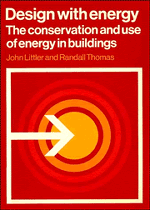Book contents
- Frontmatter
- Contents
- Units, symbols, abbreviations, conventions and conversion factors
- Preface
- 1 Energy and buildings
- 2 Site planning and analysis
- 3 Building design
- 4 Passive solar design
- 5 Active solar heating
- 6 Space heating and ventilation
- 7 Thermal storage
- 8 Wind energy
- 9 Water-supply systems
- 10 Waste disposal and utilization
- 11 Domestic-energy saving
- 12 Housing case studies
- 13 Non-domestic case studies
- Appendix 1 Weather data
- Appendix 2 Thermal performance
- Appendix 3 Interstitial condensation
- Index
2 - Site planning and analysis
Published online by Cambridge University Press: 03 February 2010
- Frontmatter
- Contents
- Units, symbols, abbreviations, conventions and conversion factors
- Preface
- 1 Energy and buildings
- 2 Site planning and analysis
- 3 Building design
- 4 Passive solar design
- 5 Active solar heating
- 6 Space heating and ventilation
- 7 Thermal storage
- 8 Wind energy
- 9 Water-supply systems
- 10 Waste disposal and utilization
- 11 Domestic-energy saving
- 12 Housing case studies
- 13 Non-domestic case studies
- Appendix 1 Weather data
- Appendix 2 Thermal performance
- Appendix 3 Interstitial condensation
- Index
Summary
Introduction
Traditional site planning includes evaluation of the aesthetics of a site, population densities, land-use patterns, slope, drainage, soil characteristics, incident solar radiation, daylighting, exposure to wind and numerous other considerations which are treated in standard works.[1, 2] In this chapter these subjects will be discussed only when specifically applicable to the use of ambient energy sources or the opportunity for energy conservation in buildings. In the more recent past the attitude of many designers has been one of ignoring both the natural characteristics of the site and the potential of solar and wind energy. Instead, they concentrated merely on avoiding potentially deleterious effects such as summertime overheating.
Important exceptions to this way of thinking include Olygay & Givoni who wrote classic works on climate and architecture [3,4] In an age of rapidly dwindling fossil-fuel reserves, though, it is important to use a site to best advantage. Fortunately, much can be done to conserve energy merely through good design, on both the large and small scale. In the former category especially, the possibilities depend on social conceptions of work, home and leisure but in the future we may see a closer integration of places of work and residence to reduce transportation energy. This could be encouraged by a gradual renovation of cities, resulting in their increasing attractiveness as places of residence and thus reducing the tendency towards suburban sprawl. For example, near the city home of one of the present authors, a former warehouse is being converted into flats. Among the results are a higher density and, for the occupants, less dependence on vehicular transport.
- Type
- Chapter
- Information
- Design with EnergyThe Conservation and Use of Energy in Buildings, pp. 14 - 41Publisher: Cambridge University PressPrint publication year: 1984



